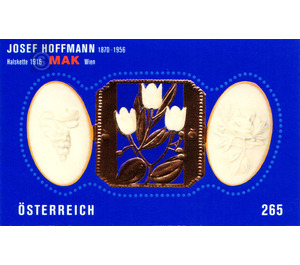Art Nouveau Hoffmann, Josef - Austria / II. Republic of Austria 2007
Theme: Well-known people
| Country | Austria / II. Republic of Austria |
| Issue Date | 2007 |
| Edition Issued | 400,000 |
| Item Type | Block |
| Chronological Chapter | OOS-OE2 |
| Chronological Issue Number | Block 40 |
| SID | 126777 |
| In 52 Wishlists | |
The brand with 24 carat gold and relief printing with Gemmeneffekt! Josef Hoffmann, born on 15.12.1870 in the Czech city of Pirnitz, attended the higher state vocational school in Brno. After a practical training as a construction trainee, he went to Vienna to the Academy of Fine Arts and studied with Carl Freiherr von Hasenauer and Otto Wagner. With several like-minded Hoffmann founded in 1897 a union of visual artists, the secession. The ancestral home, built by Josef Maria Olbrich, offered the young Hoffmann an ideal opportunity to present himself with exhibitions to an art-minded and progressive circle of potential clients. Just one year later, he was appointed professor at the School of Applied Arts. The founding of the Wiener Werkstätten in May 1903 had a profound effect on Hoffmann's life and on Viennese art life. Together with Kolo Moser and with the financial backing of the industrialist Wärndorfer, Hoffmann ran a productive cooperative of artisans. Everyday items have been redesigned and executed with the utmost precision. Beauty and individuality were another hallmark. The simplicity of the form and the geometric abstraction characterized Hoffmann's early oeuvre. A frequently recurring motif in his works was the square. His initially cubist-abstract designs weakened in the following years to moderate forms. Hoffmann later resorted to classical stylistic elements and anticipated the features of Art Deco. He was always concerned with the creative unity, so he designed the interior design of important architectural projects. From the 1920s Hoffmann retired from the management of his studio due to illness, but his creativity remained inexhaustible until his death in 1956. Hoffmann's life's work encompassed all areas of artistic design. As the initiator of the Vienna Secession, he set standards for artistic development in the 20th century. As the founder of the Wiener Werkstätte, he revolutionized the arts and crafts. As an architect and designer, he was a guide to Viennese Art Nouveau. The Republic honored Hoffmann with the awarding of the Grand Austrian State Prize. The brand image shows a detail from the necklace designed by Josef Hoffmann in 1916. The links of the chain are 2.5 cm wide, the chain itself has a length of 129 cm. As materials gold and ivory were used, the production took place in the Wiener Werkstätten. The jewel - once owned by Otto Primavesi - is now part of the Museum of Applied Arts in Vienna.


